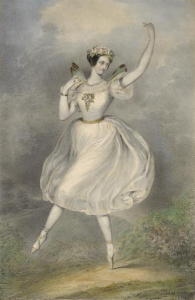Tale of a Tutu
Tale of a Tutu

Marie Taglioni wears the
first tutu in “La Sylphide.”
There was only one ballerina who could make the tutu what it is, and was, in 1832, Marie Taglioni, the era’s superstar, and the dancer whose style defined the Romantic ballet movement. In her leading role as an airy woodlands sprite in La Sylphide, Taglioni brought evervescence, lightness and grace to the stage unlike any of her acrobatic predecessors. She seemed weightless—in part thanks to her tutu, the world’s first, designed by Eugène Lami. (Taglioni, whom Joseph Cornell was obsessed with, also stars in Encyclopedia of the Exquisite.)
Parisian fashion editors went wild for Taglioni, celebrating not only her spritely dancing, but her lilting costume, which made it look like she flew. The dress was made of layered cotton gauze, with puffed sleeves and a floating transparent belt in blue silk. She wore flowers in her bodice and a crown of wildflowers in her hair. Her simple satin slippers, though popular in the ballroom, were new to the ballet, and are still worn by ballerinas everywhere today. To complete the look—a pair of transparent wings.
But while Taglioni’s costume might seem full of innocence and light now, in her own time it was the stuff of seduction. Shapely legs! Transparent skirts! Theophile Gaultier called the tutu an “abuse of white gauze, tulle and tarlatan,” and the tutu took its name from the French slang, cucu or petit cul, meaning the behind.
Quoted from; Encyclopedia of the Exquisite, Jessica Kerwin Jenkins’ first book, was published by Nan A. Talese on November 2, 2010.
